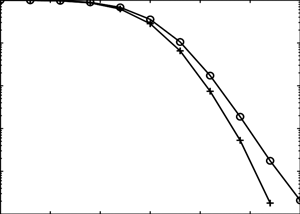Improvement of symbol error rate performance in spatial multiplexing systems using transmit antenna selection
DOI:
https://doi.org/10.3103/S0735272719120045Keywords:
VBLAST, MIMO, MMSE, SER, TAS, multiple input multiple output, minimum mean square error, vertical Bell Laboratories layered space time, maximum likelihood, ML, symbol error rate, transmit antenna selection, improved VBLASTAbstract
In this paper, we consider Mt×M system (Mt > M), where Mt and M are the numbers of antennas at the transmitter and receiver, respectively. We select M out of Mt transmit antennas using two different antenna selection schemes. In scheme 1, we select the subset of M antennas out of total (Mt_M) subsets. In the selected subset, the minimum SNR is maximum compared to minimum SNR of all the remaining subsets. In scheme 2, Mt available transmit antennas are divided into Mtg disjoint groups of successive antennas, where Mtg = Mt/N. It means that there are N antennas in each group, where N ≤ M. Further both Mt and M are divisible by N and the total possible combinations of available groups are given as (Mtg_C), where C є {1, …, Mt/N}.
Then we select the subset of M antennas out of total (Mtg_C) subsets. In the selected subset, the minimum SNR is maximum compared to minimum SNR of all the remaining subsets. In this scheme, N and C are chosen to meet the requirements of M selected antennas for transmission. After antenna selection, the resulting system will be M×M. We use Minimum Mean Square Error (MMSE) Vertical Bell Laboratories Layered Space Time (VBLAST) detection at the receiver for both the antenna selection schemes. We present MIMO Symbol Error Rate (SER) versus MIMO Symbol SNR using simulations for M-QAM constellations with Rayleigh fading channels. We have compared the performance of the considered systems with prevailing high complexity schemes ML and MMSE Improved VBLAST. The considered scheme 1 with MMSE VBLAST outperforms the prevailing schemes while scheme 2 with MMSE VBLAST provides similar performance in a wide range of SNR compared to prevailing schemes. However, the number of feedback bits used in scheme 2 is less as compared to scheme 1. There is a tradeoff between the SER performance and the number of required feedback bits. As N decreases, scheme 2 performance starts moving towards the performance of scheme 1. Both the systems provide the diversity gain in the fading channel.
References
- Paulraj, A.; Nabar, R.; Gore, D. Introduction to Space-Time Wireless Communications. Cambridge University Press, 2003. URI: https://www.cambridge.org/ua/academic/subjects/engineering/wireless-communications/introduction-space-time-wireless-communications?format=PB&isbn=9780521065931.
- Molisch, A.F.; Win, M.Z. “MIMO systems with antenna selection,” IEEE Microwave Mag., v.5, n.1, p.46, 2004. DOI: https://doi.org/10.1109/MMW.2004.1284943.
- Ghrayeb, A. “A survey on antenna selection for MIMO communication systems,” Proc. of 2nd Int. Conf. on Information and Communication Technologies, ICTTA06, 24-28 Apr. 2006, Damascus, Syria. IEEE, 2006, v.2, p.21042109. DOI: https://doi.org/10.1109/ICTTA.2006.1684727.
- Gore, D.A.; Paulraj, A.J. “MIMO antenna subset selection with space time coding,” IEEE Trans. Signal Process., v.50, n.10, p.2580, 2002. DOI: https://doi.org/10.1109/TSP.2002.803337.
- Yeoh, P.L.; Elkashlan, Maged; Yang, Nan; da Costa, Daniel B.; Duong, Trung Q. “Unified analysis of transmit antenna selection in MIMO multirelay networks,” IEEE Trans. Vehicular Technol., v.62, n.2, p.933, 2013. DOI: https://doi.org/10.1109/TVT.2012.2227862.
- Foschini, G.J. “Layered space-time architecture for wireless communication in a fading environment when using multiple antennas,” Bell Labs Tech. J., v.1, n.2, p.41, 1996. DOI: https://doi.org/10.1002/bltj.2015.
- Agrell, E.; Eriksson, E.; Vardy, A.; Zeger, K. “Closest point search in lattices,” IEEE Trans. Inf. Theory, v.48, n.8, p.2201, 2002. DOI: https://doi.org/10.1109/TIT.2002.800499.
- Guo, Z.; Nilsson, P. “Reduced complexity Schnorr-Euchner decoding algorithms for MIMO systems,” IEEE Commun. Lett., v.8, n.5, p.286, 2004. DOI: https://doi.org/10.1109/LCOMM.2004.827376.
- Gupta, V.; Sah, A.K.; Chaturvedi, A.K. “Approximate matrix inversion based low complexity sphere decoding in MIMO systems,” 2015. URI: https://arxiv.org/abs/1509.02405.
- Chauhan, Dharmendra V.; Bhalani, Jaymin K.; Trivedi, Y.N. “Improved VBLAST MAP: A novel point-to-point symbol detection algorithm for MIMO wireless communication systems,” Radioelectron. Commun. Syst., v.61, n.5, p.194, 2018. DOI: https://doi.org/10.3103/S0735272718050023.
- Wolniansky, P.W.; Foschini, G.J.; Golden, G.D.; Valenzuela, R.A. “V-BLAST: an architecture for realizing very high data rates over the rich-scattering wireless channel,” Proc. of Int. Symp. on Signals, Systems, and Electronics, 2 Oct. 1998, Pisa, Italy. IEEE, 1998, p.295-300. DOI: https://doi.org/10.1109/ISSSE.1998.738086.
- Alimohammad, A.; Fard, S.F.; Cockburn, B.F. “Improved layered MIMO detection algorithm with near-optimal performance,” Electron. Lett., v.45, n.13, p.675, 2009. DOI: https://doi.org/10.1049/el.2009.0373.
- Heath, R.W.; Sandhu, S.; Paulraj, A. “Antenna selection for spatial multiplexing systems with linear receivers,” IEEE Commun. Lett., v.5, n.4, p.142, 2001. DOI: https://doi.org/10.1109/4234.917094.
- Gore, D.A.; Heath, R.W.; Paulraj, A.J. “Transmit selection in spatial multiplexing systems,” IEEE Commun. Lett., v.6, n.11, p.491, 2002. DOI: https://doi.org/10.1109/LCOMM.2002.805517.
- Narasimhan, R. “Spatial multiplexing with transmit antenna and constellation selection for correlated MIMO fading channels,” IEEE Trans. Signal Processing, v.51, n.11, p.2829, 2003. DOI: https://doi.org/10.1109/TSP.2003.818205.
- Kim, Sangchoon. “Performance of decremental antenna selection algorithms for spatial multiplexing MIMO systems with linear receiver over correlated fading channels,” IET Commun., v.11, n.6, p.855, 2017. DOI: https://doi.org/10.1049/iet-com.2016.1059.
- Lu, Di; So, Daniel K. C. “Performance based receive antenna selection for V-BLAST systems,” IEEE Trans. Wireless Commun., v.8, n.1, p.214, 2009. DOI: https://doi.org/10.1109/T-WC.2009.070820.


